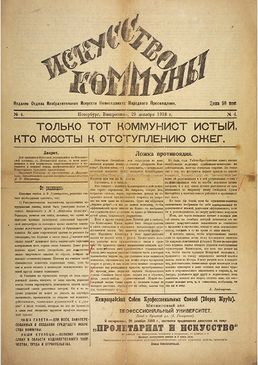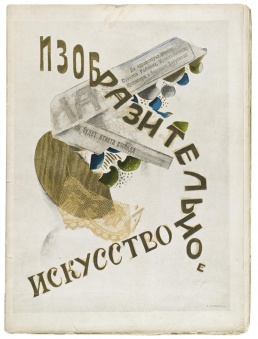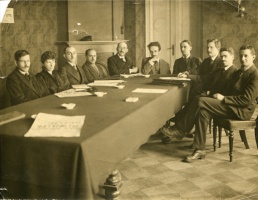IZO Narkompros
Department of Visual [Plastic] Arts [Otdel izobrazitelnykh iskusstv Narkomprosa (IZO); Отдел изобразительных искусств Наркомпроса (ИЗО)] was established in Petrograd on 29 January 1918 as part of the People's Commissariat of Enlightenment (Narkompros), a cultural organization founded in Soviet Russia in November 1917 shortly after the October Revolution, replacing the former Ministry of Culture.
Contents
Structure
- Petrograd
IZO was run by an Arts Board [Khudozhestvennaya kollegiya] which consisted of the painter David Shterenberg (president), Altman, Vaulin, Karev, Matveev, Punin, Chekhonin and Yatmanov. The board was later joined by Baranov-Rossine, Shkolnik, Mayakovsky (in Aug-Sep 1918), Brik and the architects Il'in, Dubenetsky, Rudnev, Shtal'berg and Schuko.
- Moscow
A department of IZO was also set up in Moscow and was distinguished from that in Petrograd by its inclusion of a greater proportion of members from the more extreme sections of the avant-garde. It comprised Kuznetsov, Mashkov, Morgunov, Malevich, Zholtovsky, Dymshits-Tolstaya, Rozanova, Shevchenko, Korolev, Konenkov and Kandinsky, under its president and the deputy head of IZO, Tatlin (remained head of the Moscow IZO until May 1919). One source claims the other members were Udaltsova, Nakovsky, Falk[1], while another mentions Ivanov instead of these three[2]. Co-opted members were Franketti, Fidler and Rodchenko.
- Subsections
The Kollegiya was divided into two sections, one deliberative and one executive. Subsections dealt with schools, literature, art and production [khudozhestvennaya promyshlennost'], theatre, cinema, artistic construction [konstruirovanie], and architecture.[3]
Exhibitions
In the immediate post-revolutionary period from 1918 to 1920 IZO organised 28 exhibitions. The main principle governing their organisation was the fact that they were held without any selection board restricting entry. This was reflected in their title: The State Free Exhibition [Svobodnaya gosudarstvennaya vystavka]. The first of these was the First Exhibition of Petrograd Artists of All Trends [Pervaya vystavka vsekh napravlenii petrogradskykh khudoshnikov] which opened in the Winter Palace on 13 April 1919 and comprised 299 artists exhibiting a total of 1826 works.[4]
Museums
During the same period between 1918 and 1920 the Museums Office [Muzeinoe byuro] under the direction of Rodchenko (aided by Stepanova) acquired a total of 1926 works by 415 artists. It also organised 30 museums in various Russian provincial towns to which it distributed a total of 1211 works.[5]
Artistic work
The Subsection of Artistic Work [Podotdel khudozhestvennogo truda], organised in May 1919, registered artistic organisations that would undertake Government commissions. By May 1920 it had 11 collectives on its books including Agit-poster (Agitplakat - Agitational poster), the Society of Young Artists [Obshchestvo molodykh khudozhnikov - OBMOKhU], and the Painting, Sculpture and Architecture Collective [Zhivskul'ptarkh]. Over this period the Subsection commissioned 1250 stencil posters for the anniversary of the Revolution; almost 2500 for the Abolition of Illiteracy Campaign and 280 posters for various economic organisations. It also organised competitions for various projects, including a monument to Karl Marx and a more prosaically useful kiosk for selling books and journals.[6]
Production
IZO also contained an Art and Production Subsection [Khudozhestvenno-promyshlennyi podotdel]. The programme for this department was devised by Olga Rozanova who together with Rodchenko (her assistant for a time) visited studios, raised money and basically reactivated in Moscow, Petrograd and immediate provincial areas the craft workshops that had fallen into disuse over the war period. One result of this was the First All Russian Exhibition of Art and Production [Pervaya vserossiiskaya khudozhestvenno-promyshlennaya vystavka] of 1923.[7]
Education and research
IZO also administered the new art schools (SVOMAS/VkHUTEMAS) and research institutes (INKhUK).
Publications
- Journals
IZO published several short-lived journals. Between 7 December 1918 and April 1919, it printed 19 issues of the newspaper Iskusstvo kommuny [Искусство коммуны; Art of the Commune] in Petrograd, with Brik, Kushner and Mayakovsky as its main authors; the contributors included Altman, Malevich, Pougny, and Punin. [1] [2]. Between December 1918 and April 1919, eight issues of Iskusstvo [Искусство; Art] were printed in Moscow. In 1919, one issue of its newspaper Izobrazitelnoe iskusstvo [Изобразительное искусство] was published in Petrograd, with Punin, Brik, Malevich and Kandinsky in its editorial board. [3] [4] [5] [6]. (see Lodder 1993)
- Books, booklets
- Nikolay Punin (Н. Пунин), Pamyatnik III internatsionala. Proyekt khud. E. Tatlina [Памятник III интернационала. Проект худ. Е. Татлина], Petrograd: IZO Narkompros, Summer 1920, [8] pp (28.1x22 cm), PDF, JPGs, DOC, bib.
- Iskusstvo v proizvodstve [Искусство в производстве; Art in Production], Moscow: Narkompros, 1921, 42 pp (23х18 cm). A collection of texts by Brik, Shterenberg, Filippov, Toporkov, V. Voronov, et al. [7]. Commentary: Khan-Magomedov 1996.
Literature
- D. Shterenberg, "Otchet o deyatelnosti Otdela izobrazitelnykh iskusstv Narkomprosa" [Отчет о деятельности Отдела изобразительных искусств Наркомпроса], Izobrazitelnoe iskusstvo [Изобразительное искусство] 1, 1919, p 50; repr. in Obzor deyatelnosti Otdela izobrazitelnykh iskusstv, Petrograd, 1920, pp 3-9. (Russian)
- Obzor deyatelnosti Otdela izobrazitelnykh iskusstv [Обзор деятельности отдела изобразительных искусств. Народный комиссариат по просвещению], Petrograd, 1920, 118 pp. (Russian)
- A.V. Lunacharsky, "Ob otdele izobrazitelnykh iskusstv" [Об отделе изобразительных искусств] [c1920], in Lunacharsky, Ob iskusstve, 2 [Об искусстве. Том 2], Moscow: Iskusstvo, 1982. (Russian)
- Christina Lodder, "Artists in Administration", in Lodder, Russian Constructivism, Yale University Press, 1983, pp 48-50. (English)
- Christina Lodder, "Art of the Commune: Politics and Art in Soviet Journals, 1917-20", Art Journal 52(1): "Political Journals and Art, 1910-40", College Art Association, Spring 1993, pp 24-33. (English)


